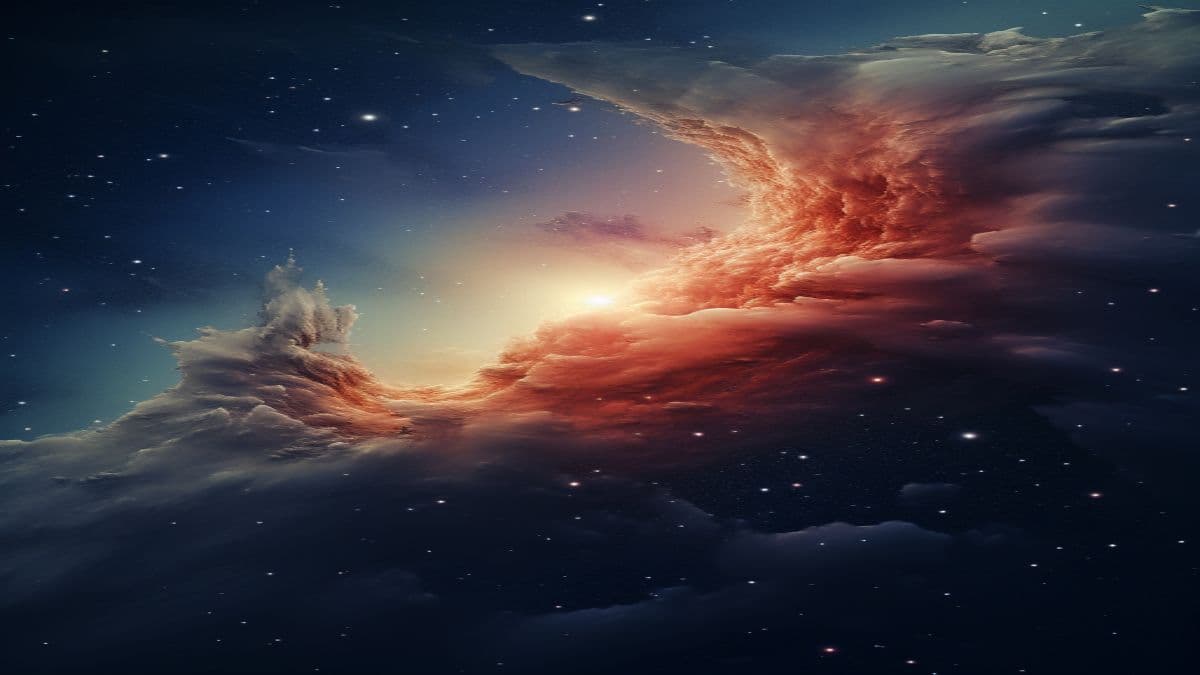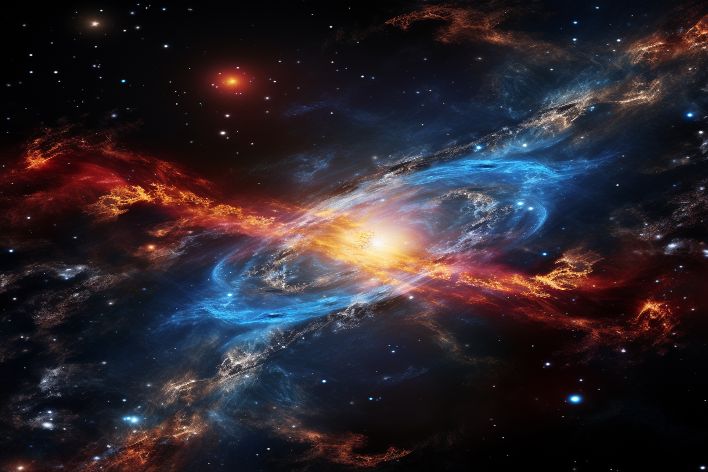The Milky Way Galaxy and Beyond
By Pinkey Sharma |
Date 08-08-2024

Table of Contents
Admissions Open for
The Milky Way Galaxy and Beyond
The universe, being such an enormous enigma, has captured human imagination for a very long time. Amongst innumerable wonders, our home galaxy, the Milky Way, shines bright as one of the most iconic objects of scientific interest and research. This blog explores mysteries of the Milky Way Galaxy, amazing galaxies beyond our own, and some other exotic phenomena, like black holes, nebulae, and supernovae.
What is Our Galaxy, the Milky Way?
Our cosmic home is situated within the barred spiral galaxy Milky Way. Stretched about 100,000 light-years across and with 100 billion to 400 billion stars, the following is an overview of some basic facts about our galaxy.
Structure and Composition
The Milky Way is composed of several key components:
Galactic Disk: This thin, disk-like structure holds the majority of the galaxy's stars, including our Sun, and is approximately 1,000 light-years thick.
The Galactic Bulge is a tightly packed area of stars and stellar debris located in the core of the Milky Way.
The galactic halo is a sparsely populated region that surrounds the disk and bulge, containing older stars and globular clusters.
The Solar System's Place in the Milky Way
Our Solar System is located in the Orion Arm, a minor spiral arm of the Milky Way, roughly 27,000 light-years from the Galactic Center. This positioning provides a relatively stable environment, shielding us from the galaxy's core's intense radiation and gravitational forces.
Formation and Evolution
Astronomers believe the Milky Way formed around 13.6 billion years ago, shortly after the Big Bang. Its evolution has been shaped by the merging of smaller galaxies and the continuous formation of new stars from interstellar gas and dust.
Exploring Other Galaxies Beyond the Milky Way
Apart from the Milky Way galaxy, there are billions of such other galaxies in the universe, each containing its features and enigmas.
Types of Galaxies
Basically, there are three general types of galaxies:

-
Spiral Galaxies: They are large, disk-shaped galaxies that rotate, similar to the Milky Way; they are also flat and have a rotating-disk shape with spiral arms. They contain a lot of gas and dust. Star formation is currently happening. An example would be the Andromeda Galaxy and the Whirlpool Galaxy.
-
Elliptical Galaxies: More rounded or oval-shaped, elliptical galaxies are filled with older, less active stars. They contain very little interstellar gas and dust and show very little new star formation. One of the best-known examples is the Messier 87, also called M87.
-
Irregular Galaxies: Irregular galaxies have no defined shape. They appear misshapen and sometimes chaotically so. They may have undergone gravitational disturbances from other nearby galaxies. The Large and Small Magellanic Clouds are two examples.
Some Famous Galaxies
-
Andromeda Galaxy M31: the nearest spiral galaxy to the Milky Way, on a collision course with our galaxy; expected to merge in about 4.5 billion years.
-
Sombrero Galaxy: The Sombrero Galaxy is a spiral galaxy 31 million light-years away with a very luminous core and large central bulge.
-
Triangulum Galaxy (M33): It is a spiral galaxy and also forms part of the Local Group, staying as a close neighbor to the Milky Way and Andromeda.
Techniques for Observing Distant Galaxies
Astronomers employ various methods to study distant galaxies:
-
Telescopes: Ground-based telescopes, like those at the Mauna Kea Observatories, and space telescopes, such as the Hubble Space Telescope, capture detailed images of galaxies far beyond our own.
-
Spectroscopy: By analyzing the light emitted or absorbed by galaxies, astronomers can determine their composition, temperature, density, and motion.
-
Radio Astronomy: Using radio waves to observe galaxies, scientists can detect otherwise invisible phenomena, such as interstellar gas clouds and pulsars.
Facts about Black Holes, Nebulae, and Supernovae
The universe is dotted with awe-inspiring objects and events, each revealing the dynamic and often violent nature of the cosmos.
Black Holes
Black holes are regions in space where the gravitational pull is so strong that not even light can escape. They are a consequence of the remains of massive stars that have collapsed in gravity.
Types of Black Holes:
-
Stellar Black Holes: They result upon collapse of the massive stars and may have masses lying between a few to some tens of solar masses.
-
Supermassive Black Holes: These are located at the centers of most galaxies, including the Milky Way, and can be as enormous as millions or billions of suns. Sagittarius A* is the supermassive black hole that rules at our own galactic center. Intermediate Black Holes: Not so much is known about these, but it is believed to create a bridge between stellar and supermassive black holes.
-
Event Horizon: The region surrounding a black hole beyond which no information can have the slightest chance of leakage; it is the point of no return.
-
Hawking Radiation: The theoretical radiation proposed by physicist Stephen Hawking purports that black holes have the capacity to lose mass and ultimately evaporate over huge timescales.
Nebulae
Nebulae are enormous collections of gaseous and dusty materials, typically acting like stellar nurseries where the birth of new stars occurs.
Types of Nebulae:
-
Emission Nebulae: The gas is ionized because of the presence of some hot stars, and it glows bright. An example would be the Orion Nebula. Reflection Nebulae—They reflect the light coming from some nearby stars. An example is the one surrounding the Pleiades star cluster.
-
Planetary Nebulae: These are the glowing ionized shells that have been ejected from dying stars in the final stages of their evolution. A famous example is the Ring Nebula. • Dark Nebulae: Small and dense dark clouds of interstellar gas and dust—practically opaque because of grains—can block light from objects lying beyond them. The Horsehead Nebula in Orion is a famous example of a dark nebula.
-
Formation and Evolution: A nebula is created from the remains of a supernova or the outflows from dying stars. It has happened many times that the gas and dust of a nebula collapse by self-gravity at the beginning of the formation of new stars.
Supernovae
Supernovae are highly powerful explosions that mark the death of massive stars. They are cataclysmic events that play a very important role in the cosmic cycle of matter.
Types of Supernovae:
Type I supernovae occur in binary systems when a white dwarf star accretes material from a partner star until it achieves critical mass and bursts.
Type II supernovae are the result of the collapse of huge stars with masses greater than eight solar masses that have completed their nuclear burning periods. Supernova Remnants: The material expelled by a supernova expands into shells of gas and dust. One of the most well-known instances of a supernova remnant is the Crab Nebula.
Impact on the Universe The supernovae spread heavy metals throughout the universe, filling the interstellar medium with building ingredients for new stars and planets. They also produce shock waves, which can cause star formation in the surrounding gas and dust clouds.
The Role of Astronomers in Unraveling Cosmic Mysteries
Astronomers are very critical in helping man move forward in understanding the universe. Their observations, hypotheses, and discoveries continue to have a bearing on our current understanding about galaxies, black holes, nebulae, and supernovae.
Historical Contributions.
-
Galileo Galilei: Galileo made many important discoveries using a telescope, such as moons for Jupiter and phases for Venus; these were not agreeable to the then-geocentric understanding of the universe.
-
Edwin Hubble: It was through his work that the expanding universe and the existence of galaxies beyond the Milky Way were discovered, changing our picture about the universe fundamentally.
Modern Techniques and Technologies
Space Telescopes: From the Hubble Space Telescope to next generation James Webb Space Telescope, such instruments have opened new vistas for the human population in getting views of far away galaxies and other cosmic phenomena.
Radio Astronomy: The Very Large Array (VLA) and the Atacama Large Millimeter/submillimeter Array (ALMA) are only a couple of instances of many available radio astronomy facilities that have opened up windows for considering celestial radiations in radio wavelengths.
Gravitational Wave Detectors: The LIGO, Virgo, and other facilities have been brought into operation to track the ripples in spacetime from very massive cosmic events, like mergers of black holes.
Current and Future Missions
James Webb Space Telescope: To fly soon, the JWST a study of the early universe, star formation and exoplanets with unmatched sensitivity and resolution.
Euclid Space Mission: it will map the geometry of the dark universe by making observations of billions of galaxies, studying dark matter, and dark energy for the European Space Agency.
Collaborative Efforts
Astronomy is a collaborative science where researchers and institutions across the world
pool their resources to solve great mysteries of the universe. International collaborations, such as the Event Horizon Telescope project, have seen tremendous success with the very first image of a black hole.
Conclusion
The Milky Way Galaxy and the cosmos beyond offer an endless array of wonders for astronomers and enthusiasts alike. From the spiral arms of our home galaxy to the distant reaches of the universe, each discovery fuels our curiosity and deepens our understanding of the vast, intricate tapestry of the cosmos. As we continue to explore and learn, the role of astronomers, the advancements in technology, and the sheer wonder of the universe will undoubtedly lead us to new frontiers of knowledge and awe. The journey through the Milky Way Galaxy and beyond is a testament to humanity's enduring quest to understand our place in the universe.
Faqs :
Is there anything beyond the Milky Way galaxy?
Our galaxy is part of a collection of galaxies called the Local Group, which includes the Milky Way; the Andromeda galaxy; a smaller spiral galaxy called Triangulum; and several dwarf galaxies, including the Large and Small Magellanic Clouds.
What is beyond the milky?
Immediately beyond the Milky way is intergalactic space containing extragalactic gas and dust. Some of this exists as clouds with the potential to contract into stars and galaxies themselves, although this is increasingly rare in the contemporary universe. There are also rogue stars and planets outside the Milky Way.
Can we exit the Milky Way?
So, to leave our Galaxy, we would have to travel about 500 light-years vertically, or about 25,000 light-years away from the galactic centre. We'd need to go much further to escape the 'halo' of diffuse gas, old stars and globular clusters that surrounds the Milky Way's stellar disk.
Can humans go to the Milky Way?
Even if you could travel at the speed of light (300,000 kilometers, or 186,000 miles, per second), it would take you about 25,000 years to reach the middle of the Milky Way. If we could travel outside our galaxy and look back, this is what our Milky Way Galaxy might look like from above.
For more knowledge about planets and galaxies stay tuned...
Related blogs:
Space Exploration and Missions: Discover humanity's historic space milestones and adventurous missions.
Astronomy for Kids: Explore space with fun and educational astronomy activities for kids.
Tools for Young Astronomers: Discover the greatest equipment for junior stargazers right here!
CBSE Schools In Popular Cities
- CBSE Schools in Bangalore
- CBSE Schools in Mumbai
- CBSE Schools in Pune
- CBSE Schools in Hyderabad
- CBSE Schools in Chennai
- CBSE Schools in Gurgaon
- CBSE Schools in Kolkata
- CBSE Schools in Indore
- CBSE Schools in Sonipat
- CBSE Schools in Delhi
- CBSE Schools in Rohtak
- CBSE Schools in Bhopal
- CBSE Schools in Aurangabad
- CBSE Schools in Jabalpur
- CBSE Schools in Jaipur
- CBSE Schools in Jodhpur
- CBSE Schools in Nagpur
- CBSE Schools in Ahmednagar
- CBSE School In Tumkur

Call Us to know more about Orchids
Swipe Up



.jpg&w=1920&q=80)












